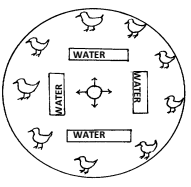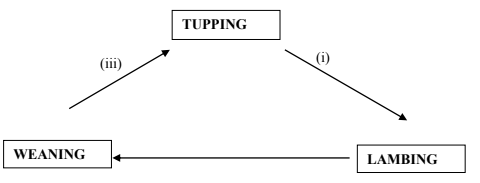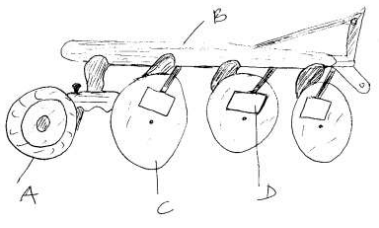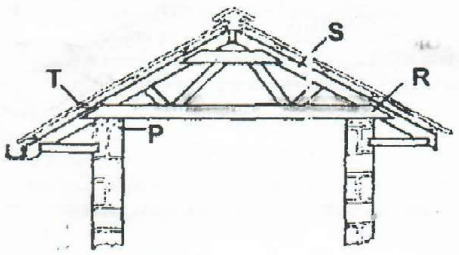INSTRUCTIONS TO CANDIDATES
- This paper consists of three sections: A, B and C.
- Answer all the questions in section A and B and any two questions from section C
SECTION A (30 MARKS)
- Name four light breeds of poultry. (2mks)
- State two reasons that would make a farmer prefer to keep indigenous cattle breeds instead of exotic cattle breeds. (1mk)
- Give two reasons for having a footbath in a cattle dip. (1mk)
- Distinguish between crutching and ringing in sheep management. (2mks)
- State four signs that indicate that a doe is about to kindle. (2mks)
- State two conditions that make a cow to withhold milk during milking. (1mk)
- State four uses of a spring tine harrow. (2mks)
- State four signs of mite attack in poultry. (2mks)
-
- State three advantages of natural feeding in calf rearing. (11/2 mks)
- Give four advantages of Artificial Insemination. (2mks)
- Give three ways in which infectious diseases can spread from one livestock to another within a farm. (1½ mks)
- State four reasons for castration in pig production. (2mks)
- State four characteristics of roughage livestock feeds. (2mks)
- Give two reasons for turning eggs regularly during incubation? (1mk)
- State four roles of worker bees in a colony. (2 marks)
- Give four reasons for controlling livestock diseases. (2mks)
- State three ways of caponisation in poultry. (1½ mks)
- State four advantages of using animals instead of tractors as a source of power on the farm. (2mks)
- Name one livestock disease that is transmitted by each of the following parasites:
- Blue ticks; (½mk)
- Brown ear ticks; (½mk)
- Tsetse flies. (½mk)
SECTION B (20 MARKS)
- Study the diagram below and answer the questions that follow.
- Name the structure illustrated above. (1mk)
- Why should structure be round and not rectangular or square shaped. (1mk)
- Describe the heat situation in the structure. (1mk)
- Give one reason to support your answer in (iii) above. (1mk)
- Why is saw dust not suitable for use as litter in the structure? (1mk)
- Below is a breeding cycle of a ewe in relation to the feeding regime accompanying it. Use it to answer the following questions.
- Name the management practice represented by (i),(ii) and (iii) (3mks)
- Give the importance of practice (i) (2mks)
- The diagram below shows a tractor drawn implement. Study it and answer the questions that follow.
- Name the parts A, B, C and D. (2mks)
- State two advantages of using the above implement over mould- board plough. (2mks)
- State the function of the parts labeled. (1mk)
- A
- D
- The following diagram shows a part of a roof. Study it carefully and answer the questions that follow.
- Name the parts labeled P, T, R and S. (2mks)
- State the functions of P and T. (2mks)
- Give two chemical preservatives for treating timber before use in the construction of farm structures (1mk)
SECTION C (40 MARKS)
-
- Describe the life cycle of a three host tick. (8mks)
- Give three tools used in construction of a wooden fence stating the use of each. (3mks)
- State five management practices done on an incubator. (5mks)
- State four factors that should be considered when selecting dairy goat for breeding. (4mks)
-
- Discuss the general methods of controlling livestock diseases (10mks)
- Give five advantages of four-stroke cycle engines (5mks)
- Describe the essentials of clean milk production in dairy farming (5mks)
-
- State five advantages of embryo transplant. (5mks)
- Describe coccidiosis disease under the following sub- headings.
- Animals attacked (2mks)
- Causal organism (1mk)
- Symptoms (4mks)
- Control measures (3mks)
- A ration containing 20% DCP for growing chicks is to be obtained by mixing ground maize containing 10% DCP and fishmeal containing 50% DCP. Calculate the amount of each feedstuff in kilograms required to prepare 200kg of the feed (5mks )

MARKING SCHEME
- Name four light breeds of poultry. (2mks)
- Sykes
- leghorns
- ancona
- minorcas
- Sykes
- Reasons that a farmer opts to rear indigenous cattle breeds over the exotic breeds ( 1 mk)
- They can withstand high temperatures
- They are capable of walking for long distances in search of pasture and water.
- They are more resistant to most of tropical diseases and pest attack
- They can survive on poor quality pastures
- They can withstand high temperatures
- Reasons for having foot bath in a cattle dip.
- Clean the feet of animals
- Control foot rot Rej. Control of diseases (2 x 1/2 = 1 mk)
- Clean the feet of animals
- Crutching and ringing
- Crutching is the cutting of wool around the external reproductive organs of a female sheep to facilitate mating
Ringing is the cutting of wool around the sheath of the penis in rams to facilitate mating. (Mark as a whole 1 mark)
- Crutching is the cutting of wool around the external reproductive organs of a female sheep to facilitate mating
- Signs of kindling in a doe.
- Nest building
- Plucking of fur From the body
- Loss of appetite.
- Restlessness. (4 x ½ = 2 marks)
- Nest building
- State two conditions that make a cow to withhold milk during milking. (1 mark)
- Washing a cow with hot water.
- Beating the cow(mistreatment)
- Change of milking man.
- Unfamiliar noise.
- Absence of food during milking.
- Washing a cow with hot water.
- Uses of a spring -tine harrow.
- Levelling the seedbed.
- Breaking soil clods.
- Burying trash
- Aerating the soil. (4 x ½ =2 mks)
- Levelling the seedbed.
- Signs of mite attack in poultry,
- Irritation/scratching of the body.
- Anaemia,
- Presence of mites below the plumage in patches.
- Falling off of feathers.
- Dermatitis due to burrowing effects.
- Formation of crusts. (4 x ½ = 2 mks)
- Irritation/scratching of the body.
-
- Advantages of natural feeding in calf rearing.
- Calf takes milk at body temperature,
- Milk is free from contamination
- it prevents scouring in calves.
- Milk is provided ad libitum. (3 x ½ = 1 ½ mks)
- Advantages of Artificial Insemination (2mks)
- Easier to transport semen
- Improved hybrid vigour
- Controls inbreeding
- Prevents breeding diseases
- Removes cost of rearing a bull
- Heavy bulls with good features can produce semen
- Easier to transport semen
- Advantages of natural feeding in calf rearing.
- Ways in which infectious diseases can spread
- Through vectors
- Through ingestion of contaminated food and water/through food and water
- Through contact
- Through inhalation of contaminated air/through air. (3 x 1/2 = 11/2 mks)
- Through vectors
- Reasons for castration
- Prevent uncontrolled mating.
- Improve the quality of meat
- Promote faster growth/facilitate weigh gain
- Make then docile
- Control breeding diseases
- Control inbreeding (4 x 1/2 = 2 mks)
- Prevent uncontrolled mating.
- Characteristics of roughages
- Bulky
- High fiber content
- Low nutrient content
- Low digestibility (4 x 1/2 = 2 mks) 1
- Give two reasons for turning eggs regularly during incubation? (1mk)
- To prevent germinal disc from sticking on the shell as this may cause death of the embryo.
- To make sure warmth is distributed evenly around the egg for uniform embryo.
- Roles of worker bees.
- Kills the drones after mating the queen
- Scouting for a new home
- collect nectar/water/gum/propolis/pollen
- Make honey combs
- Protect the colony
- Kills the drones after mating the queen
- Reasons for controlling livestock diseases.
- Reduces spread of livestock diseases/production of healthy young ones
- Promote fast growth and early maturity - rej to maintain good health in livestock
- Make them have long productive life.
- Improve quality and safety of products
- Improve quantity of products
- Reduce cost of production. (4 x 1/2 = 2 mks)
- Caponisation in poultry.
- Surgical /open method.
- Implanting pellets of the female sex hormone beneath the skin of the bird.
- Injecting with stilbestol hormone when they are one day old. (3 x ½ = 1 ½ marks)
- Surgical /open method.
- Advantages of using animal power.
- Animals are cheap to acquire /maintain.
- Require less skilled labour.
- Can be used on, small holdings.
- Are appropriate in very steep areas. (4 x ½= 2 mks)
- Animals are cheap to acquire /maintain.
-
- Blue ticks – Anaplasmosis/Gall sickness
- Brown ear ticks - E.C.F/Teireriosis,
- Tsetse flies - Trypanosomiasis (nagana) (3x ½ =1 ½ mks)
SECTION B
-
- Brooder (1mk)
- To avoid flocking/crowding of chicks at the corners which may lead to suffocation and eventually death (1mark)
- Hot
- The chicks have moved away from the heat source.
- It clogs the gizzard of the birds leading to indigestions and death (1mk)
-
-
- Steaming up (1mk)
- Lactation/milk production (1mk)
- Flushing (1mk) (b)
-
- Facilitates rapid foetal development
- Reduces incidences of twin lamp disease /pregnancy/toxaemia.
- Increases and maintains high milk yield after birth.
- Ensures birth of a healthy animal.
- Give the ewe good condition for parturition. (1 x 2 = 2mks)
-
-
-
- A furrow wheel or rear thrust
- B beam
- C disc
- D disc scrapper 4x1/2 = 2mks
- Advantages of using the above implement over mould board plough. 2x1 = 2mks
- Good on rough field with stones, stumps or roots not easily broken by obstacles
- Good on wet, heavy and sticky soils
- Good on hard and dry soils by cutting various depth
- Can be used on soil prone to soil erosion
- Requires less power to pull
- Requires less maintenance
-
- A
- For balancing the whole implement
- Also used to adjust the depth of plough
- D
- To remove wet soils from the disc
- Aid in the turning and inverting of the furrow slice (1mk)
- A
-
-
- Name the parts labelled P, T, and R S. (2marks)
- P-Wall plate. 1x ½ = ½ mk
- T- Purlin. 1x ½ = ½ mk
- R- Tie beam / cross tie. 1x ½ = ½ mk
- S- Rafter 1x ½ = ½ mk
- State the functions of P and T. (2mks)
- P- Hold the trusses securely.
- T- Hold the roofing materials.
- Give two chemical preservatives for treating timber before use in the construction of farm structures
- tar, creosol, tanex, used engine oil and copper sulphate solution.2x ½ = 1mk
- Name the parts labelled P, T, and R S. (2marks)
SECTION C
-
- Describe the life cycle of a three host tick. (8mks)
- Eggs hatch into larvae on the ground
- Larva climbs on the first host.
- Larvae feed, sucks blood on first host.
- Engorged larvae drops on to the group and moult into nymph
- Nymph climbs onto the second host and feed on blood.
- Engorged nymph drops to the ground and moult into adult.
- Adult climb on the third host, feed on blood and mate
- Engorged female drop to the ground and lay eggs. 8x1=8mks
- Eggs hatch into larvae on the ground
- Give three tools used in construction of a wooden fence stating the use of each. (3mks)
- Hand saw- this is for cutting timber to the recommended sizes.
- Claw hammer-for driving in nails into the work surface or out of the surface ∙ Plumb bob and line-ensures that the fence posts are vertical.
- Hole digger/soil auger-for digging the holes.
- Ramming rod-to firm the soil around the posts.
- Garden line- to establish straight lines. any 3x1=3mks
- Hand saw- this is for cutting timber to the recommended sizes.
- State five management practices done on an incubator. (5mks)
- Egg turning after every 6-8 hours each day around 1800(but not done in the first 24 hours and last 3days)
- Remove broken eggs
- Maintain temperature at the appropriate range always.
- Add water if necessary to maintain the appropriate humidity always.
- Remove infertile eggs on the 5th day. 5x1=5mks
- Egg turning after every 6-8 hours each day around 1800(but not done in the first 24 hours and last 3days)
- State four factors that should be considered when selecting dairy goat for breeding. (4mks)
- Should be a high milk producer.
- Should be healthy.
- Should be fertile
- Should be docile/mild temperature
- Should have a good mothering ability
- Should be disease resistant/tolerant.
- Should be adaptable to area to be kept. Any 4x1= 4mks
- Should be a high milk producer.
- Describe the life cycle of a three host tick. (8mks)
-
- Discuss the general methods of controlling livestock diseases (10mks)
- Proper feeding and nutrition to avoid deficiency disorders
- Proper selection and breeding to get disease resistant animals
- Proper housing and hygiene to avoid overcrowding e.g. pneumonia
- Isolation of sick animals to avoid contact e.g. foot and mouth
- Imposition of quarantine/legislation of rinderpest
- Use of prophylactic drugs e.g. coccidiostats
- Regular vaccinations to induce immunity e.g. brucellosis
- Slaughtering and burning or burying of infected animals e.g. anthrax
- Use of antiseptics and disinfectants e.g. in foot rot control
- Full vector control e.g. ticks and tsetse flies
- Treatment of sick animals to avoid source of infection
- Appropriate method of handling animals to avoid injury e.g. during branding, dehorning etc. 1x10=10mks
- Proper feeding and nutrition to avoid deficiency disorders
- Give five advantages of four-stroke cycle engines (5 mks)
- The engines produce high power and can do heavy farm work
- Have efficient fuel and oil utilization
- Perform a wide range of farm operations
- Engines are efficiently cooled with water thus allowing the production of large engine sizes ∙ The exhaust gases are effectively expelled from the cylinders 1x5=5mks
- The engines produce high power and can do heavy farm work
- Discuss the general methods of controlling livestock diseases (10mks)
- Describe the essentials of clean milk production in dairy farming (5mks)
- Healthy dairy cows not suffering from mastitis etc.
- Clean dairy cows (teats)
- Healthy milk man not suffering from TB etc.
- Clean milking shed
- Clean milking utensils
- Clean milkman i.e. whole body
- Milk filtration, cooling and storage
- Proper feeding to avoid flavors in milk
- Proper milking technique without injuring teats
- Use of all recommended milking materials e.g. udder cloth, filtering pads, etc. 1x5=5mks
- Healthy dairy cows not suffering from mastitis etc.
-
- State five advantages of embryo transplant. (5mks)
- It is possible to implant embryo from a high quality female to less valuable female and hence improve the performance of the offspring.
- It stimulates milk production in a female that was not ready to produce milk.
- A highly productive female can be spread over a large area to benefit many farmers.
- It is easier to transport embryos in test tubes than the whole animal.
- Embryos can be stored for long periods awaiting availability of a recipient female.
- It is possible to implant embryo from a high quality female to less valuable female and hence improve the performance of the offspring.
- Describe coccidiosis disease under the following sub- headings.
- Animals attacked (2mks)
- Calves, poultry, lambs and young rabbits.
- Causal organism (1mk)
- Coccidia of the Eimeria spp
- Symptoms (4mks)
- Diarrhoea which may be whitish.
- Dysentery or blood in the dung.
- Birds have ruffled feathers, dull with drooping wings.
- Animals become emaciated
- Sudden death in birds, rabbits and kids.
- Diarrhoea which may be whitish.
- Control measures (3mks)
- Use of coccidiostats.
- Observing hygiene.
- Isolation in cattle.
- overcrowding in a poultry house should be avoided.
- Use of coccidiostats.
- Animals attacked (2mks)
- A ration containing 20% DCP for growing chicks is to be obtained by mixing ground maize containing 10% DCP and fishmeal containing 50% DCP. Calculate the amount of each feedstuff in kilograms required to prepare 200kg of the feed. (5mks)
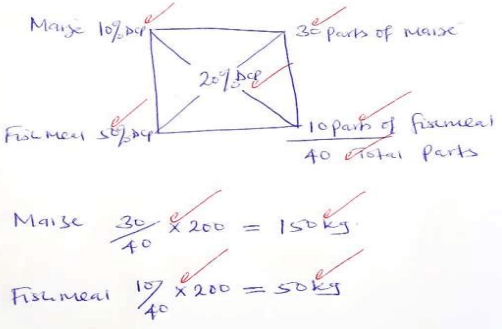
- State five advantages of embryo transplant. (5mks)
Download Agriculture Paper 2 Questions and Answers - Lanjet Joint Mock Exams 2022.
Tap Here to Download for 50/-
Get on WhatsApp for 50/-
Why download?
- ✔ To read offline at any time.
- ✔ To Print at your convenience
- ✔ Share Easily with Friends / Students

